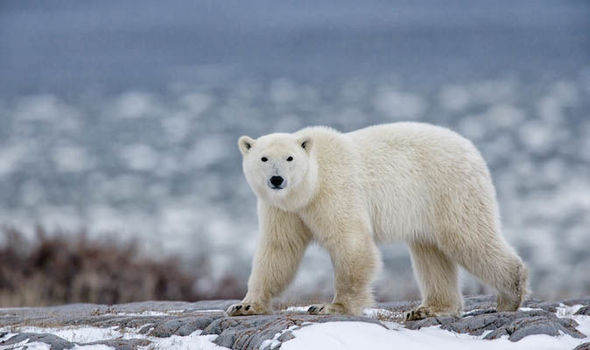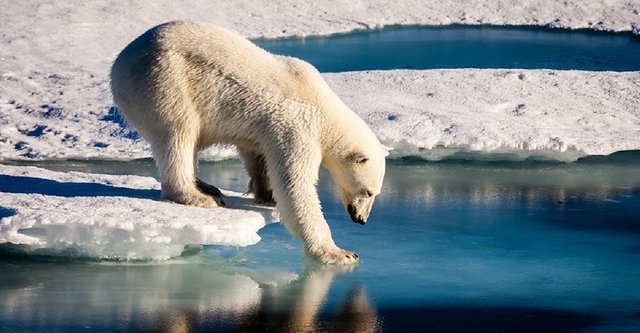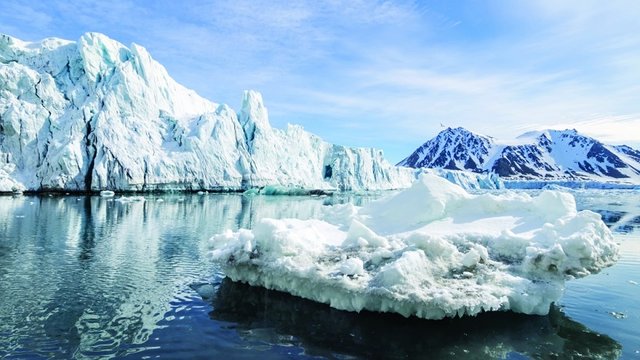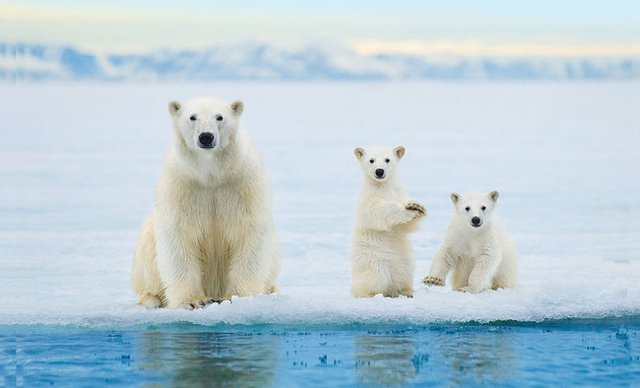Warning! Warming! How Global Warming Affects Polar Bears
Hello smart Steemians!
I guess everyone knows about the global warming happening on our planet. These changes negatively affect life of many animals. And today I want to talk about the impact of global warming on one of the most amazing animals – polar bear.
Polar bears also known as white bears are carnivorous mammals of the bear family, close relatives of the brown bear. Polar bears are the largest land predators of our planet. They live in the northern hemisphere of Earth.
Appearance.
The polar bear is a very large animal. Its length could reach 3meters (9.8ft), and its weight could be up to 1 ton. Usually males weigh about 400-450kg (0.45 ton), body length 200-250cm (8.2ft). The females are noticeably smaller - 200-300kg (0.3ton) and body length is near about 160-250cm (8ft). The smallest bears are found on Spitsbergen, and the largest - in the Bering Sea.
Spitsbergen or Svalbard is a polar archipelago located in the Arctic Ocean.
You can distinguish a polar bear from other bears by a long neck and a flat head. An interesting feature is that the skin of white bear is black. The color of the coat varies from white to yellowish. In summer, the fur acquires a yellowish tinge due to the constant exposure to sunlight. The soles of the feet are lined with wool, so as not to slide over the ice and do not freeze. Between the fingers there is a swimming membrane, and the front part of the paws is trimmed with rigid bristles. Polar bears have large claws and with their help they can hold even very large prey.
Lifestyle and nutrition.
Polar bears live on drifting sea ice and also hunt there. Their main preys are - bearded seal, walrus, ringed seal and other sea creatures. How does white bear catching prey? He hides in shelter or waits near the holes and once the animal stick its head out of water, polar bear by punch stuns prey and pulls it out onto the ice. Sometimes polar bear overturns the ice floe where the seals are, thus capturing them as prey. With walrus things are more complicated; the bear can cope with him only on land. First of all, when polar bear eats its prey, it devours the skin and fat, the remaining carcass - only in case of severe hunger. From extraction a polar bear receives a large amount of vitamin A, which accumulates in its liver. At convenient occasions, the white bear can picks up carrion, dead fish, eggs and chicks, can eats grass and seaweed, in the habitable places feeds on rubbish. There were incidents when polar bear made robberies of warehouses with food from polar expeditions.
Polar bears make seasonal roosts in accordance with the annual changes in polar ice border. In summer they retreat with it closer to the pole, in winter they move to the south, going to the mainland. Although the polar bear rests primarily on the coast and ice, in winter it can lie in a den on the mainland or on islands, sometimes 50km (31mi) from the sea. Pregnant females are lying in winter hibernation, lasting 50-80 days. Males and single females go into hibernation for a short time and not annually.
The white bears are wonderful swimmers. They swim and dive remarkably well. On land they are also quick and dexterous, although seem very clumsy. When bears swim their thick and dense wool protects the body from cold and getting wet in icy water. They have a big layer of subcutaneous fat up to 10cm (3.9inch) thick. White coloring of fur serves as camouflage. Bears have a well-developed sense of smell, sight and hearing. They can see their prey a few kilometers away.

The climate of Earth is becoming warmer every year, and in Arctic it’s warming two times faster than on the rest of planet. Especially warming is marked in Alaska, northwest of Canada and Asian coast of the Arctic Ocean.
The Arctic is a polar region, located at the northernmost part of Earth. It consists of the Arctic Ocean, adjacent seas, and parts of Alaska (US), Northern Canada, Sweden, Finland, Iceland, Greenland (Kingdom of Denmark), Norway and Russia.
The climate of Arctic has experienced considerable fluctuations over the last 600 years. Climatic research in the polar latitudes dates back to 1553, when Sir Hugh Willoughby tried to find the northeastern sea route from England to India and China. Seafarers during the hikes described all the events on board, as well as in details set out the climatic conditions of the Arctic. These climatic studies of seafarers of the past centuries were taken advantage by Norwegian scientists. After studying the archives and modern satellite data, they built a huge number of maps giving information on the distribution of sea ice in the Arctic from 1553 to 2002.
The situation in Arctic began to change dramatically in the 20th century. Satellite photographs show that the cover of Arctic ice from 1970 to 2002 was reduced by 25%. The Arctic’ ice has a great importance for the Earth's climate system. The ice cap reflects the sun's rays and thus does not allow the planet to overheat. Also, arctic ice plays an important role in the water circulation systems in the oceans. But most of all climatic changes in Arctic affect plants and animals, in particular polar bears.
Survival conditions.
The white bear is listed in the International Red Book. Slow reproduction and high mortality make this beast easily vulnerable. Polar bears have a low breeding potential. At first time female brings offspring at the age of 4-8, gives birth once in 2-3 years and has 1-3 cubs, thus, during the lifetime bringing no more than 10-15 cubs. Bear cubs remain with mother up to 1.5 years, all this time mother-bear feeds them with milk. Mortality among the cubs reaches 10-30%. Life expectancy of polar bears maximum 25-30 years.
In addition to natural factors that are dangerous for polar bear’s life, they are also destroyed by Arctic inhabitants - the Eskimos. They kill polar bears for the sake of skins and meat. In Russia white bear’ hunting is completely banned since 1956, in other countries (Canada, USA, Greenland) is limited.
So, we can note that the life of polar bears is full of dangers and this species is steadily decreasing. What will happen to them in conditions of global warming?
"Over the past ten years, we have observed in what state the white bears are, how varies the number of their populations and how often they die. We found out what exactly caused the sharp decline in the number of these animals, comparing how much energy they spend each day and how often they manage to catch seals", - said Anthony Pagano, ecologist from the University of California at Santa Cruz, USA.
According to ecologists, the number of polar bears can be reduced to a critically low level during 10 years if the northern ice will continues to decline at the current record pace. Reducing area of Arctic ice negatively affects the daily life of polar bears, forcing them to spend more energy during seal hunting. Therefore, global warming can provoke a famine among polar bears and, as a consequence, species extinction. White bears catch their food on the surface of sea ice and their white skin, which serves as camouflage, helps them creep to seals and catch them. If there will be no ice, the bear will be deprived of camouflage and he will have almost no chance of catching prey. This will cause him to starve for a long time.
Scientists have conducted huge number of studies and observed the life of polar bears. These observations revealed two serious problems. First, scientists have found that these predators spend very large amount of energy even in those times when they are starving. Polar bears do not reduce the metabolic rate and body temperature with a lack of food, as do many other mammals. Secondly, they found that today polar bears catch and eat far fewer seals than they have in the past. The reason is simple - the retreat of glaciers towards the pole makes predators spend more time searching for suitable hunting grounds, which is especially evident in summer and autumn, when food is scarce and the ice retreats as far as possible from the shores of Arctic.
If the ice will continue to decline, these predators, which appeared on Earth relatively recently, could become the first major victim of global warming in the next two decades.

Causes of global climate change have been studied for a long time. And the main cause of climate changes is considered to be the so-called greenhouse effect, which creates by greenhouse gases. Most scientists maintain this position. However, there is another point of view; some researchers believe that the current warming is only one of the stages of a natural change in climatic cycles. If to suspend global warming, whatever it’s caused by, is very difficult, so maybe need to find options how to help polar bears and prevent the species from disappearing. White bears are the largest land predators of the planet. And besides, they are so cute.
References:
- https://polarbearsinternational.org/polar-bears/name-evolution/
- https://polarbearsinternational.org/polar-bears/characteristics/
- https://polarbearsinternational.org/polar-bears/life-cycle/
- https://www.worldwildlife.org/blogs/good-nature-travel/posts/ten-facts-about-polar-bears
- https://www.livescience.com/27436-polar-bear-facts.html
- https://www.nationalgeographic.com/animals/mammals/p/polar-bear/
- http://www.sciencemag.org/news/2018/02/polar-bears-are-starving-and-video-reveals-why
- http://www.sciencemag.org/news/2010/12/how-save-polar-bears



